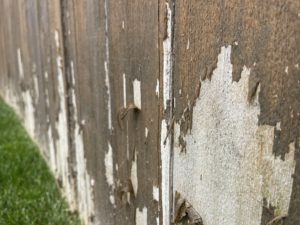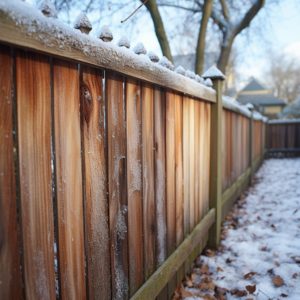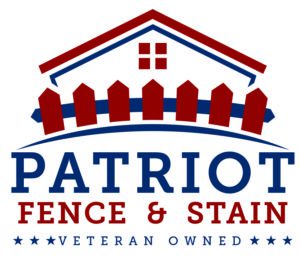If you’ve recently stained your fence, you may be asking yourself; do I need to seal my fence after staining? The short answer is no. Here is why:
Staining your fence is a great way to improve its appearance and extend its lifespan. Stain comes in two basic families; oil based penetrating stains and film forming stains. Each of them seal the fence in different ways. First, let’s take a look at film forming stains which is not what we recommend to homeowners to stain their privacy fence, deck, or pergola with.
Film Forming Stains usually come in two different forms, acrylic and latex based. Acrylic based film forming stains are a type of wood stain that contains acrylic resins. These stains are designed to penetrate the wood and create a film on the surface, which helps to protect the wood from the elements. Latex-based film-forming wood stains are a type of wood stain that is made with latex and other synthetic resins. These stains create a film on the surface of the wood that provides protection against moisture, UV rays, and other environmental factors. Film forming stains include Olympic, Behr, and Thompsons water seal to name a few. Here are some of the benefits of these types of stains:
- Durability: Acrylic and latex based stains are known for their durability. The acrylic or latex resins form a protective film on the surface of the wood, which helps to prevent moisture from penetrating the wood. This makes the wood more resistant to rot, decay, and insect damage, which can extend the lifespan of your wood.
- UV protection: Acrylic and latex based stains are also known for their UV protection. The film created by the resins helps to prevent the sun’s UV rays from damaging the wood. This can help to prevent fading and discoloration, which can keep your wood looking great for a long time.
- Water resistance: Acrylic and latex based stains are also water-resistant. The film created by the resins helps to repel water, which can prevent the wood from absorbing moisture. This can help to prevent warping, splitting, and cracking, which can all be caused by moisture damage.
- Versatility: Acrylic and latex based stains are also versatile. They can be used on a variety of wood surfaces, including decks, fences, and siding. They come in a wide range of colors that can be custom blended, so you can find a stain that matches your desired aesthetic.
Here are some of the draw backs to film forming stains:
- Peeling and Flaking: Acrylic and Latex based stains are highly susceptible to peeling, cracking, and flaking, especially on cedar privacy fences, decks and exterior wood trim. As the wood breaths it expands and contracts. This process causes the membrane to stretch until it ultimately fails and splits. Once moisture gets underneath the membrane it begins to peel, and flake off leaving your fence looking unkempt and an eyesore.
- Hidden Water Damage: With acrylic and latex film forming stains once the membrane gets microscopic tears and cracks in it, water begins to get into the underlying wood. This moisture causes the wood to begin to break down, decay, rot, warp and split. Unfortunately, by the time the home owner realizes the membranes have failed, the damage to the underlying wood has already been done.
- Upkeep and maintenance costs: With film forming stains, once they have begun to peel and flake the underlying stain has to be scraped, and stripped off before a new coat can be re-applied. This process can often times cost more than the original price of having the wood stain. Once completed, you still have the full cost of applying a new coat of film forming stain. Once you have used a film forming surface stain, you cannot go back over it with an oil based penetrating stain without completely stripping it off down to the bare wood.

Now let’s look at oil based penetrating stains and discuss why they are the preferred choice for staining and sealing wood fences decks and exterior wood trim:
Oil-based penetrating wood stains are a type of wood stain that penetrates the wood fibers and provides a protective layer from within. Unlike film-forming stains, which create a surface film, oil-based penetrating stains seep into the wood and protect it from the inside out. Penetrating oils have been the go to choice of craftsman for centuries. Wooden ship timbers were treated with penetrating oils to prevent them from taking on water, warping and rotting. There are ships today sailing the world with 200+ year old original wooden timbers. Here are some of the benefits of using oil-based penetrating wood stains:
- Deep penetration: Oil-based penetrating stains penetrate deep into the wood fibers, which can provide better protection against moisture, UV rays, and other environmental factors. This deep penetration also helps to enhance the natural beauty of the wood by highlighting its natural grain patterns and texture.
- Natural finish: Oil-based penetrating stains provide a natural finish that allows the wood to breathe. This natural finish is ideal for exterior wood surfaces such as decks, fences, and siding as it allows the wood to expand and contract with changes in temperature and humidity.
- Easy maintenance: Oil-based penetrating stains are easy to maintain. Unlike film-forming stains, which can peel or flake over time, oil-based stains gradually wear away and can be easily re-applied when needed.
- Long-lasting protection: Oil-based penetrating stains provide long-lasting protection for your wood. They never crack, peel or flake and will simply fade over time while preventing rot and decay.
- Versatility: Oil-based penetrating stains can be used on a variety of wood surfaces, including cedar, redwood, and pressure-treated lumber. They come in a range of colors, from clear to dark brown, so you can find a stain that matches your desired aesthetic.
In comparison to film-forming wood stains, oil-based penetrating stains offer the benefit of deeper penetration into the wood fibers, which can provide better protection and a more natural finish. They are also easier to maintain and offer long-lasting protection.
In summary, oil-based penetrating wood stains offer a range of benefits, including deep penetration, a natural finish, easy maintenance, long-lasting protection, and versatility. They are our top recommendation for those who want to enhance the natural beauty of their wood and provide long-lasting protection against the elements. If you would like to know more about how we can protect your cedar privacy fence, deck, pergola or exterior wood trim with high quality oil based penetrating wood stains we would love to hear from you!




